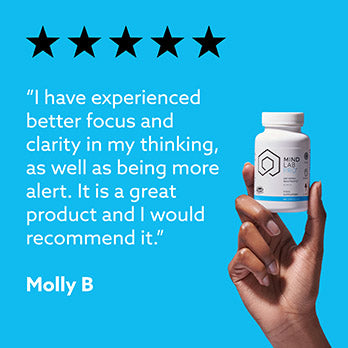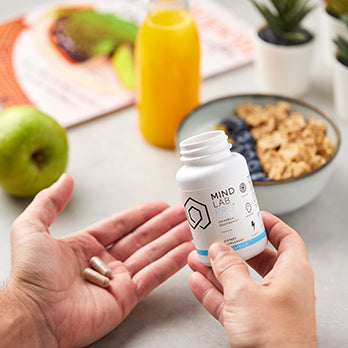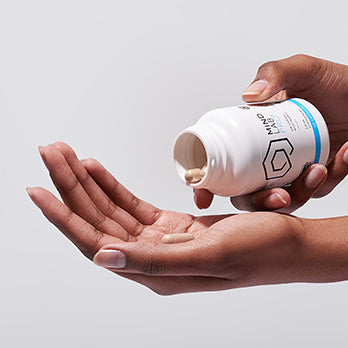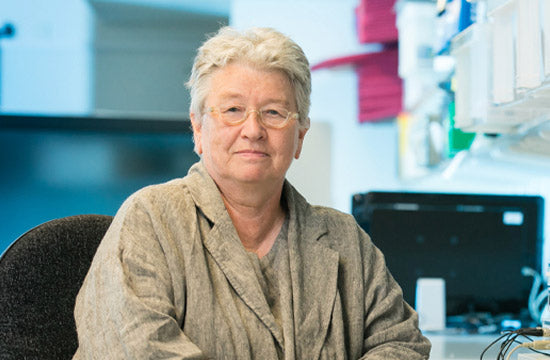Today's going to be a busy one. Lots to do...
So, first things first, let's just have a little scroll through our socials.
That way we'll know we're not missing anything. And then we can really focus all our attention on what we need to do.
Sound like a plan?
Sounds like a good one, but it rarely plays out like that.
One post leads to another, and another, and before you know it, an electric jellyfish aquarium will be arriving on Monday.
You've disappeared down another internet black hole.
Any motivation you did have, has now been sapped. Which is bad news for your to-do list. Because now you really do need to get on.
Why do we do it?
Scrolling social media gives us an instant hit of dopamine. (1)

It's a quick and dirty way to get our dopamine fix. Why is it bad? Because regular, easy access dopamine hits can lead to desensitization. Our brains get used to these frequent dopamine spikes and over time, we require more stimulation to achieve the same sensation.
As a result, those not-so stimulating activities, such as the ones on your to-do list, can seem less rewarding. Which makes it harder to motivate ourselves to do them. And this is where the idea of a dopamine menu, or 'dopamenu' can come in handy.
What is a dopamine menu?

The idea gained popularity after being featured in a YouTube video by Jessica McCabe from the channel "How to ADHD". (2) It was intended as a tool for people with ADHD. The theory being, that if we deliberately engage in activities that bring us joy, we can increase dopamine levels which can help with motivation and concentration.
The USP of this tool, is that the structured approach recognizes that not all dopamine is created equally.
Just like food, it's all about balance.
A dopamine menu categorizes dopamine-stimulating activities into sections like those you'd see on a restaurant menu. Starters, mains, sides, and desserts translate into small, easily accessible tasks and more significant, higher-effort endeavors.
In much the same way we approach a balanced diet, this menu is about selecting the right combination of activities to ensure a healthy, sustained dopamine 'diet.'
Whilst constantly opting for desserts might satisfy a sweet tooth, it won't meet our overall nutritional needs. Likewise, repeatedly seeking quick dopamine spikes, such as scrolling our feed, can lead to a similar 'sugar-crash' effect on our motivation.
But how does this help with our to do list?
The idea is to create a personalized list of activities that make us happy. And by doing this, we gain a mental pick-me-up when we need it most. This in turn, kickstarts our motivation.

We're more likely to be motivated when our mood is lifted. So categorizing the natural ways we get our dopamine, means we can get what we need, when we need it, and when it's convenient.
Examples of Dopamine Menus
Starters: These are the quick and easy tasks that don't lure you into distraction. Starters work well as a break or as a tool to boost motivation for bigger tasks.
- Take a short walk.
- Listen to a favorite song.
- Put your washing away.
- Have a little dance.
- Spend a few minutes deep breathing.
Mains: These are engaging activities that take a little more time, but are generally more fulfilling.
- Go for a run.
- Get outside for a walk.
- Re-organize your wardrobe.
- Engage in creative hobbies.
- Spend quality time with friends.
- Do something that makes you laugh.
Sides: Add these to your 'mains' if they need to be made a little more interesting.
- Listen to a podcast or music.
- Put a film on in the background.
- Call a friend.
- Work alongside someone.
Desserts: Be careful with these, they're very more-ish, but the dopamine hit doesn't last long. Consume sparingly to avoid the crash.
- Check social media.
- Re-enter the WhatsApp group chat.
- Eat a sugary snack.
- Watch an episode of a bingeable tv series.
- Play a game on your phone.
The Science Behind Dopamine Menus
Dopamine is a neurotransmitter that plays a critical role in the brain's reward system. It helps regulate movement, attention, learning, and emotional responses. (3) The concept of the dopamine menu taps directly into this system.
The Brain's Reward System

When something happens in your environment, or you think of something your brain interprets as potentially rewarding, dopamine is released.
Watching a clip of squirrels waterskiing, or achieving a personal best...
Dopamine's not fussy.
When this 'feel-good' neurotransmitter is released, it travels to the nucleus accumbens (NAc) - a key player in the brain's pleasure and reward circuit. Here, the intensity of the pleasurable response can vary - some experiences may trigger a stronger response, leading to a more powerful reinforcement signal, while others result in a milder reaction.
Whilst all this is happening, the prefrontal cortex, known for its involvement in decision-making and planning, evaluates the entire event. Like judge and jury, the prefrontal cortex and the NAc, collaborate to determine the value of an experience, and whether it should be pursued again.
But hang on...
If the reward system determines whether an action should be repeated - wouldn't that mean we're all inclined to continue scrolling social media?
How does this help us start less dopamine-triggering tasks?
It's true the brain is inclined to repeat these actions. But the purpose of the dopamine menu is to strategically leverage this inclination. Do something that releases dopamine, and you can ride that wave into your list of less rewarding tasks. Here's how it helps:
Mood Elevation: Engaging in a dopamine activity from the menu can elevate your mood and overall outlook. (4) When you're feeling happier and more positive, you're typically more willing to tackle tasks that might not be as immediately rewarding.
Activation Energy: Sometimes, the hardest part of doing a task is getting started. Engaging in a quick, rewarding activity can provide a burst of energy or "activation energy" needed to begin a less appealing task.
Building Momentum: The dopamine menu can be structured to include both highly rewarding activities and those that are moderately rewarding but more productive. By starting with something enjoyable, you build momentum that can carry over into the next task, even if it's less exciting. The key is to transition smoothly from high dopamine activities to those that are necessary but less stimulating.
Scheduled Rewards: The dopamine menu can be used to create a reward system where engaging in less pleasurable tasks is directly followed by something from the menu. This creates an association between completing necessary tasks and receiving a reward, gradually making the less pleasurable tasks more appealing.
Breaking Procrastination Cycles: For someone stuck in a loop of procrastination, engaging in a small, enjoyable task can break the cycle of inactivity. It shifts us from a state of avoidance to one of action, making it easier to transition to more productive tasks.
Cognitive Reappraisal: Engaging in an enjoyable activity can sometimes provide a mental break, allowing you to return to your tasks with a fresh perspective. This cognitive reappraisal can make the task seem less daunting and more manageable.
Neurological Training: Over time, by consistently following the dopamine menu and then returning to work or less exciting tasks, we can train our brain to better handle transitions between high and low dopamine activities. It's about creating a balance and understanding that not all tasks will be equally rewarding, but they can lead to long-term satisfaction and achievements.
Who Benefits from Dopamine Menus
The dopamine menu was originally conceived as a strategy for those with ADHD. People with ADHD tend to have lower levels of dopamine. (5) Which can make it difficult to start or complete tasks. This strategy can help ADHDers overcome the inertia or lack of motivation often experienced due to this dopamine deficiency.
But it can be a useful tool for anyone who struggles with focus, procrastination, or low energy.

Most of us have moments where our self-discipline/motivation needs a little gentle encouragement. The dopamine menu is a strategy for anyone looking to boost their mood and increase motivation.
The Neuroscience of Motivation
Motivation can feel like something that's out of our control.
You've either got it or you haven't.
Like a hot air balloon experience that's been booked for months and is dependent on weather, we've got things to do - we're just waiting for the right conditions to start them.
But for most of us, this misconception places us in a needlessly passive position.
Motivation is rooted in our brain's functions.
At the core of motivation, are seven key neurotransmitters. Dopamine is just one of them. Each of these play a unique role in aspects like reward pursuit, focus, and energy levels.
- Dopamine plays a crucial role in motivation, particularly in the anticipation of rewards, driving us toward pleasurable activities and reinforcing rewarding actions.
- Serotonin regulates mood, impacting motivation. Balanced levels promote a positive, stable mood. (6)
- Norepinephrine (Noradrenaline) is linked to arousal and alertness, vital for action and motivation, especially under stress. (7)
- Epinephrine (Adrenaline), related to norepinephrine, boosts energy and stress response, indirectly affecting motivation. (8)
- Acetylcholine focuses on attention and memory, aiding in goal-oriented motivation.
- Glutamate, the main excitatory neurotransmitter, supports learning, memory, and the reward system, essential for sustained motivation. (9)
- Gamma-Aminobutyric Acid (GABA), though inhibitory, helps manage anxiety and overstimulation for balanced focus and motivation. (10)
These chemicals significantly influences our mood, stress levels, and motivation. Understanding how these neurotransmitters interact in our brain, can help us understand why certain activities can lift us up, and help us focus.
Bottom line
Forget about productivity tools, finding a little more joy in our day is never a bad thing. Dopamine menus are a great way to highlight the healthier and more sustainable ways to boost our mood.
By consciously selecting activities that provide a balanced mix of dopamine-releasing experiences, we not only enhance our immediate pleasure but also contribute to long-term emotional and cognitive well-being. This approach goes beyond instant gratification, it's about cultivating a lifestyle that consistently nurtures our brain's health.
The next time you find yourself in a rut or lacking motivation, turn to your dopamine menu, select an activity, and let the waves of positivity wash over you.
References
- https://pubmed.ncbi.nlm.nih.gov/25489985/
- https://www.youtube.com/watch?v=-6WCkTwW6xg
- https://www.ncbi.nlm.nih.gov/pmc/articles/PMC3032992/
- https://www.ncbi.nlm.nih.gov/pmc/articles/PMC3155128/
- https://pubmed.ncbi.nlm.nih.gov/1652243/
- https://pubmed.ncbi.nlm.nih.gov/11888576/
- https://pubmed.ncbi.nlm.nih.gov/16226365/
- https://pubmed.ncbi.nlm.nih.gov/1852011/
- https://pubmed.ncbi.nlm.nih.gov/2428340/
- https://pubmed.ncbi.nlm.nih.gov/8550953/




































